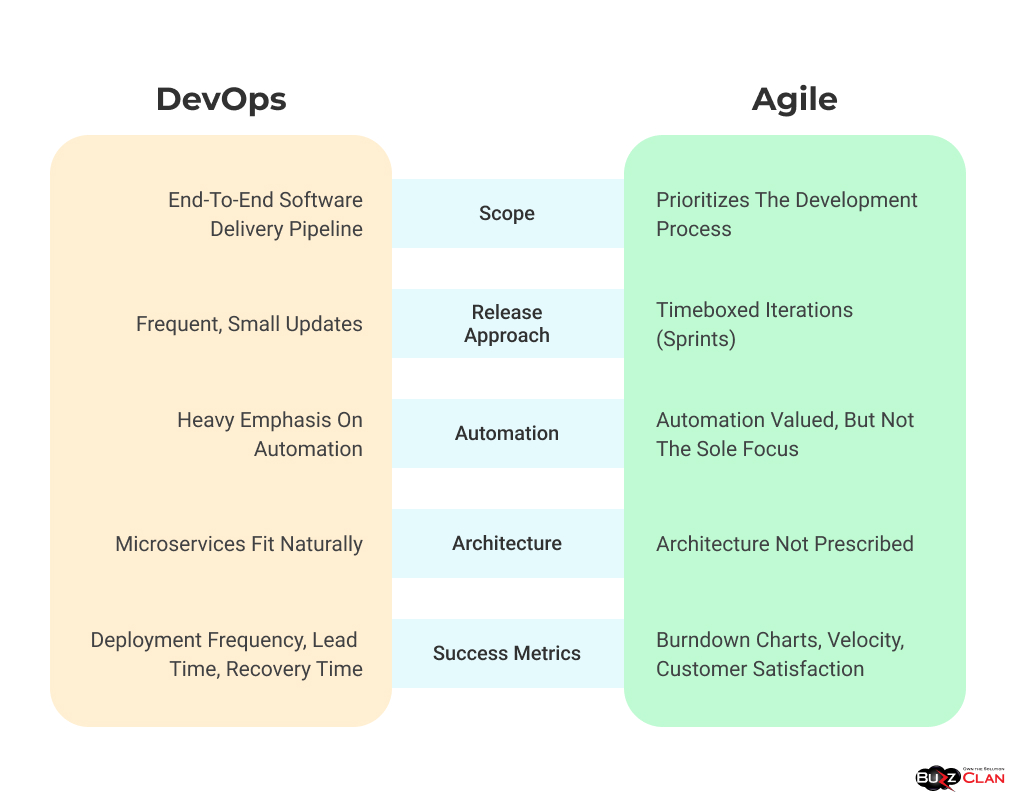DevOps vs Agile: Key Differences Explained
Neha Nair
Aug 21, 2024
Introduction
DevOps and Agile have emerged as crucial disciplines enabling technology teams to deliver innovation faster and more reliably. Both methodologies deeply transform how modern software organizations operate. However, their mechanisms differ meaningfully.
This comprehensive guide will demystify the contrasts between DevOps and Agile – traversing their histories, underlying cultural ethos, toolchain focus variances, success metrics, and business impacts. We’ll examine integration strategies and adoption considerations while exploring interplay with connected frameworks like Scrum.
By the end, you will have clarity regarding the synergies between DevOps and Agile, helping teams continuously uplift productivity, quality, and customer experiences. Let’s dive in!
Understanding DevOps and Agile
DevOps Core Principles
DevOps strategically brings development and IT operations teams closer through improved collaboration shared ownership, and automation to enhance the speed and stability of software delivery. It focuses on the following:
- Improving deployment frequency using continuous integration/delivery
- Infrastructure as code for consistency across environments
- Shifting security and compliance into daily workflows
- Resilience engineering and site reliability best practices
- Observability, monitoring, and AIOps driven responsiveness
Agile Pillars
Agile is an iterative approach to software project management using short cycles and constant feedback for incremental development. Its pillars include:
- Direct business participation driving priorities
- Small cross-functional teams with autonomy
- Working software deliverables more valued over documentation
- Responding to change rather than rigid planning
- Continuous refinement driven by customer feedback
Structural and Role Comparison
While DevOps expands collaboration between developer and operational roles, Agile provides frameworks for engagement between builders and business leadership upholding customer needs. Scrum masters steward value delivery through active backlog grooming, while DevOps focuses on consistent value stream flow.
Key Differences Between DevOps vs Agile

Cultural Ethos
DevOps inherits and advances the collaborative, feedback-driven Agile cultural ethos by expanding it deeper into technology infrastructure and security domains beyond application team silos. It also further ingrains computational thinking using broader automation.
Release Methodology
Agile uses timeboxed sprints for incremental feature delivery, whereas DevOps emphasizes continuous integration and deployment mechanisms, enabling teams to release changes safely and rapidly at any time.
Automation Focus
Agile relies on processes and rituals to drive outcomes. In contrast, DevOps doubles down on automating error-prone manual tasks using infrastructure as code, policy rigor, and intelligent orchestration capabilities, allowing teams to sustain reliable velocity at scale.
Architecture Impacts
While Agile provides software development guardrails, DevOps transformations instill holistic modernization spanning legacy monolith refactoring, decentralization for resilience, harnessing cloud-native patterns, and uplifting site reliability – impacting end-to-end stack.
Success Measurement
DevOps assessments focus on lead time, deployment frequency, change failure rate, and restoration velocity, while Agile measures working deliverables completion, burn rates, and story point progress week over week.
Aligning DevOps and Agile Strategies
While differences exist, DevOps and Agile complete rather than compete with each other. Thoughtful integration unlocks immense synergies.
Complementary Strengths
Blending Agile’s customer obsession through grooming feedback loops with DevOps’ pursuit of computational excellence across the delivery lifecycle simultaneously uplifts responsiveness, innovation velocity, and system resilience.
Integrated Workflows
Using mature Agile ceremonies to continually validate and prioritize feature work transparency while harnessing DevOps CI/CD pipelines to take code safely into production maximizes business impact.
Automating Testing Tradeoffs
DevOps expands test automation across UI, load, integration, and chaos dimensions, while Agile upholds exploratory testing rigor and customer scenario coverage through living documentation – blending velocities needed for sustainable differentiation.
Enabling Shared Ownership
Cross-pollinating talent through mutual shadowing, dual-track career ladders, and unified rituals around postmortems and showcases broadens collective ownership, securing reliability and creativity jointly.
Adoption Considerations for Businesses
Organization Realities Set Pace
Greenfield digital teams harness DevOps natively while legacy cultures thoughtfully balance ongoing Agile improvements, mainframe constraints, and transitional roadmaps when charting integrated cloud adoption.
Building Leadership Vision
Uniting isolated efforts requires appealing to wide-angle metrics conveying customer satisfaction, value delivery pacing, and branding beyond feature outputs – allowing tradeoff debates productively balancing functionality, quality, and continuity using data and empathy.
Curating Toolchains
Custom-blending best-of-breed point solutions, carefully auto-integrating ceremonies globally while applying progressive upgrades using loose architecture patterns, uplifts success in drafting changes using peer insights rather than following ephemeral fads unthinkingly.
Mitigating Talent Struggles
Reskilling for automation and ownership equally across silos needs respecting transformation anxieties around job impacts using patience and inclusion – ultimately furthering careers by removing obsolete toil, enabling intrinsically motivating creativity.
The Interplay of DevOps, Agile and Scrum
Enabling Self-Organization
Loosely integrating Scrum ceremonies, DevOps practices, and Agile culture primes teams intrinsically, seeking peak performance by upholding autonomy and mastery secured through evolutionary architecture safety nets rather than controls alone.
Uniting Azure Pipelines with Boards
Microsoft’s Azure DevOps platforms natively blend capabilities supporting Agile planning/tracking, CI/CD pipeline automation, source tracing, and integration analytics – facilitating transparency and codifying changes securely using fine-grained access governance, minimizing risks.
Optimizing Outcomes and Experiences
Beyond chasing isolated velocity gains, thought optimization should ultimately further experiential KPIs around employee engagement, customer loyalty, and brand credibility, sustaining innovative market leadership through differentiated offerings.
Conclusion
In closing, Agile and DevOps evolved, solving complementary domain challenges around optimizing application functionality pacing and holistic system reliability – but stronger together. Uniting development teams with business and operations goals through shared ownership and automated intelligence allows organizations to deliver innovations that users trust and value continually and sustainably.
Which aspects of reconciling Agile and DevOps resonate from initiatives in your current context? What use cases need more thoughtfully harmonizing project outputs with platform maturity capabilities, avoiding friction? Please share further perspectives enriching adoption journeys!
FAQs

Get In Touch
